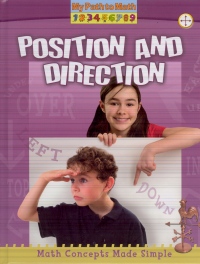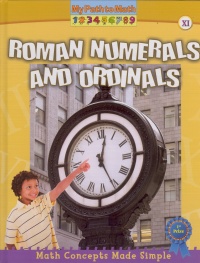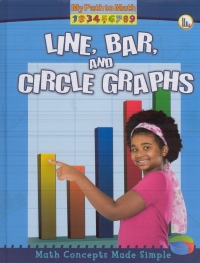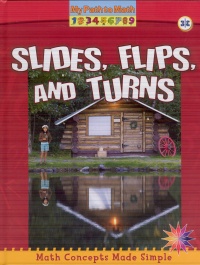| ________________
CM . . . . Volume XVII Number 10. . . .November 5, 2010. 
 |
Position and Direction. (My Path to Math).
Claire Piddock.
St. Catharines, ON: Crabtree, 2010.
24 pp., pbk. & hc., $7.95 (pbk.), $18.36 (RLB.).
ISBN 978-0-7787-5295-0 (pbk.), ISBN 978-0-7787-5248-6 (RLB.).
Subject Heading:
Topology-Juvenile literature.
Kindergarten-grade 2 / Ages 5-7.
Review by Thomas Falkenberg.
***/4
|
| |
|
 |
Roman Numerals and Ordinals. (My Path to Math).
Kylie Burns.
St. Catharines, ON: Crabtree, 2010.
24 pp., pbk. & hc., $7.95 (pbk.), $18.36 (RLB.).
ISBN 978-0-7787-5297-4 (pbk.), ISBN 978-0-7787-5250-9 (RLB.).
Subject Headings:
Roman numerals-Juvenile literature.
Numbers, Ordinal-Juvenile literature.
Grades 1-4 / Ages 6-9.
Review by Thomas Falkenberg.
***/4
|
| |
|
 |
Line, Bar, and Circle Graphs. (My Path to Math).
Claire Piddock.
St. Catharines, ON: Crabtree, 2010.
24 pp., pbk. & hc., $7.95 (pbk.), $18.36 (RLB.).
ISBN 978-0-7787-5294-3 (pbk.), ISBN 978-0-7787-5247-9 (RLB.).
Subject Headings:
Graphic methods-Juvenile literature.
Mathematics-Charts, diagrams, etc.-Juvenile literature.
Grades 1-5 / Ages 6-10.
Review by Thomas Falkenberg.
***/4
|
| |
|
 |
Using a Calculator. (My Path to Math).
Marsha Arvoy & Dorianne Nardi.
St. Catharines, ON: Crabtree, 2010.
24 pp., pbk. & hc., $7.95 (pbk.), $18.36 (RLB.).
ISBN 978-0-7787-5299-8 (pbk.), ISBN 978-0-7787-5252-3 (RLB.).
Subject Heading:
Calculators-Juvenile literature.
Grades 1-3 / Ages 6-8.
Review by Thomas Falkenberg.
***/4
|
| |
|
 |
Slides, Flips, and Turns. (My Path to Math).
Claire Piddock.
St. Catharines, ON: Crabtree, 2010.
24 pp., pbk. & hc., $7.95 (pbk.), $18.36 (RLB.).
ISBN 978-0-7787-5298-1 (pbk.), ISBN 978-0-7787-5251-6 (RLB.).
Subject Headings:
Geometry-Juvenile literature.
Shapes-Juvenile literature.
Transformations (Mathematics)-Juvenile literature.
Grades 3-5 / Ages 8-10.
Review by Thomas Falkenberg.
**/4
|
| |
|
 |
Lines, Segments, Rays, and Angles. (My Path to Math).
Claire Piddock.
St. Catharines, ON: Crabtree, 2010.
24 pp., pbk. & hc., $7.95 (pbk.), $18.36 (RLB.).
ISBN 978-0-7787-5292-9 (pbk.), ISBN 978-0-7787-5245-5 (RLB.).
Subject Headings:
Angles (Geometry-Juvenile literature.
Line geometry-Juvenile literature.
Grades 3-6 / Ages 8-11.
Review by Thomas Falkenberg.
**/4
|
| |
|
 |
Probability. (My Path to Math).
Marina Cohen.
St. Catharines, ON: Crabtree, 2010.
24 pp., pbk. & hc., $7.95 (pbk.), $18.36 (RLB.).
ISBN 978-0-7787-5296-7 (pbk.), ISBN 978-0-7787-5249-3 (RLB.).
Subject Heading:
Probabilities-Juvenile literature.
Grades 4-6 / Ages 9-11.
Review by Thomas Falkenberg.
*/4
|
| |
|
 |
Percentage. (My Path to Math).
Marsha Arvoy & Dorianne Nardi.
St. Catharines, ON: Crabtree, 2010.
24 pp., pbk. & hc., $7.95 (pbk.), $18.36 (RLB.).
ISBN 978-0-7787-5293-6 (pbk.), ISBN 978-0-7787-5246-2 (RLB.).
Subject Heading:
Percentage-Juvenile literature.
Grades 4-7 / Ages 9-12.
Review by Thomas Falkenberg.
*/4
|
| |
|

excerpt:
Soon it will be Grandma’s birthday! Sofia wants to make her a birthday card. Sofia’s mom helps gather materials. They look for shapes to put along the borders of the card.
They move the shapes in different ways to see how the shapes look. Sofia’s mom tells her about transformations. The different ways a shape can be moved on a flat surface are called transformations. (From Slides, Flips, and Turns.)
The eight books reviewed here represent a third of what has now grown to 24 books in the series “My Path to Math” by Crabtree Publishing. The series is designed for primary grade students and teachers. Each of the volumes has 24 pages. Each double-page in a volume addresses one particular aspect of the mathematical concept and idea the whole volume deals with. The text is printed in larger font (appropriate for primary school children), and there are many coloured pictures and images used that often provide a pictorial representation of the respective mathematical concepts and ideas. Each volume has an index page at the end as well as a double-page glossary in which the central terms used in the respective volume are explained in one sentence.
All the volumes reviewed here are written to help students with developing conceptual understanding of mathematical concepts and ideas. Practicing procedural fluency is not part of any of the books. The volumes do a very good job in extracting the central ideas of each concept a volume deals with and provide some meaningful activities for students to engage in (mentally or physically) to help the reader with the respective concept. Understandable, representing the network of ideas behind a concept like percentage on 21 large-print pages with pictures is not an easy undertaking. A number of the conceptual links between the different aspects of the bigger concept of percentage will have to appear only indirectly or not at all. For instance, on page 16 in the volume Percentage, the two authors of this volume address different notational ways of representing 75%. They write, “The 75% can also be written as the fraction 75/100. We can also call this number three-fourths. It represents three out of four parts, or 3/4.” The link between the two fraction 75/100 and 3/4 is not made clear. The special limitations should, though, not distract from the overall very good presentation of the different conceptual aspects behind the bigger idea of percentage.
While the basis upon which each volume deals with a particular mathematical concept and idea is sound in terms of what a teacher should consider in her teaching of mathematics, the volumes are, in my view, of only limited value as books for students to learn from by reading them on their own. This has to do with what the publisher seems not to acknowledge. The book series has a motto that is printed at the bottom of each cover: “Math Concepts Made Simple”. Mathematical concepts and ideas are complex and abstract, and they cannot be made simple. Understanding mathematical concepts and ideas requires engagement with those concepts and ideas in meaningful and various ways. Mathematics education research would strongly suggest that the different aspects of mathematical concepts like multiplication, division, symmetry, and so on cannot be learned by students reading a double page. It requires engagement with a number of different tasks, generally facilitated by a teacher; and it is as a teacher’s resource to engage students in thinking about mathematical ideas that I see the primary value of the book series. Supplemented with other materials and activities, the volumes provide teachers with a number of mental and physical activities and visual representations that teachers can use to engage students with the respective mathematical ideas and concepts in a meaningful way.
Some of the reviewed books have received lower recommendation ratings than other books in the series. This was due to those books dealing with mathematical concepts that the mathematical curricula (at least the ones for the western provinces of Canada) deal with in grades beyond the primary grades. For instance, probability concepts start in those curricula in grade 5, as are concepts around lines, perpendicular line segments, and so on. Percentage, even, is listed in those curricula starting in grade 6. The books in this series, however, are by design for primary grade students.
Recommended with reservations.
Thomas Falkenberg is a mathematics teacher-educator in the Faculty of Education at the University of Manitoba.

To comment on this title or this review, send mail to
cm@umanitoba.ca.
Copyright © the Manitoba Library Association. Reproduction for personal use is permitted only if this copyright notice is maintained. Any other reproduction is prohibited without permission.
NEXT REVIEW |
TABLE OF CONTENTS FOR THIS ISSUE- November 5, 2010.
AUTHORS |
TITLES |
MEDIA REVIEWS |
PROFILES |
BACK ISSUES |
SEARCH |
CMARCHIVE |
HOME |







